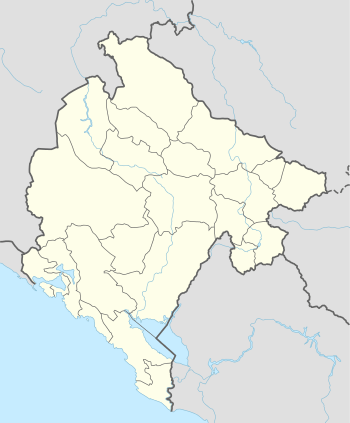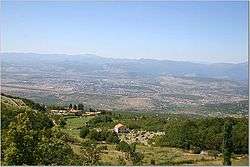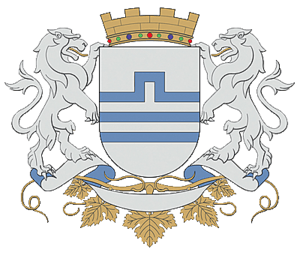Koći
| Koći | |
|---|---|
|
Panorama of Koći | |
 Koći Location of Koći in Montenegro | |
| Coordinates: 42°27′38″N 19°24′13″E / 42.46056°N 19.40361°ECoordinates: 42°27′38″N 19°24′13″E / 42.46056°N 19.40361°E | |
| Country |
|
| Municipality | Podgorica Municipality |
| Population (2011) | |
| • Total | 54 |
| Time zone | CET (UTC+1) |
| • Summer (DST) | CEST (UTC+2) |
| Area code | +382 20 |
| Car plates | PG |
Koći (Montenegrin and Serbian Cyrillic: Коћи, Albanian: Kojë) is a settlement in Podgorica Municipality, Montenegro, near the border with Albania. The village is inhabited by ethnic Albanians of the Roman Catholic faith.
Geography
Koći lies east of the capital Podgorica, north of Ubli. Koći is a village in the southeastern part of Kuči, called Kučka Krajina ("Kuči frontier")[1] in eastern Montenegro, bordering Albania (see this geo-morphological map, legend B30). Kučka Krajina also compose Orahovo, Zatrijebač and Fundina.[2] Kuči is one of the seven highlander tribes that constituted Brda ("the Hills") in the Principality of Montenegro.
Along with Albanian-inhabited Hoti and Gruda, Koći is, from Albanian point of view, part of the wider Malësia-region (Malesija).[3]
History
Early history
In the mid-15th century Kuči is mentioned as a Serbian Orthodox tribe.[4] When the Ottoman Empire occupied the Kuči area, the 1484 Ottoman defter (tax registry) registered 208 households in 11 villages. In the next one, 1497, it had had 338 households in 9 katuni (Pavlovići, Petrovići, Lješovići, Bitidosi, Lopari, Bankeći, Banjovići, Lazorce and Koći) and 2 villages.[5]
17th to 19th century
The Koći area had only Serbian hamlets prior to the Albanian immigration in the 17th century.[6] The families that are known to have inhabited Koći prior to the Albanian immigration were: Bakečević and Loparci (Banjović, now in Lopare), along with other families whose surnames are not known.[4] The Albanians (Mari and Gorvoki), originally from Vukelji in Klimenti, had moved from Podgrad in Orahovo to Koći where they found Serbs who they expelled by force, except the Bakečević whom they subsequently entered kinship with and Albanianized.[7] The plot of Jabuka was first settled in the first half of the 18th century, when the Kuči moved families there from the village of Kućište at the sources of the Ribnica river, due to Kućište being an obstacle in the warfare against the Ottomans.[7] Those families, Ivačević and Purušić, then moved to Koći after quarreling with the lord of Jabuka, and entered kinship with the Mari, and subsequently Albanianized.[7] In the mid-18th century, the Stjelović fled Rovca and settled Jabuka. The Albanian Nuculović originally from Kastrati, had settled in Jabuka after the Stjelović, whom they befriended. At the end of the 18th century there was fighting between the Albanian Koći and Kuči Serbs, after which the Nuculović together with the Stjelović moved from Jabuka to Koći, where the Stjelović subsequently Albanianized.[7] By the early 19th century, the families of Serb origin in Koći were fully Albanianized.[8] The Albanian immigrants in Koći were divided from the Kuči at the beginning, while the Albanians and Albanized Serbs in Zatrijebač, divided somewhat geographically from Kuči, acted more as their own tribe.[9] The Albanians settled down when Kuči had some kind of tribal organization together with the Malissori, from which the only remnant of Malissori tribes are the small Zatrijebač and Koći, who are today part of the united tribe of Kuči.[10]
At the beginning of the Montenegrin–Ottoman War, the Kuči rose up against the Ottomans, who started dispatching soldiers at the frontier, including at Koći.[11] The Piperi and Kuči together attacked Koći, of whom they killed a small part, and defeated, while they found Turks in tower houses whom they wanted to destroy with wooden cannons.[12] A Kuči epic poem regarding the war tells how Abdi Pasha the Cherkessian with 20,000 soldiers from the sanjak of Scutari and the sultan went to attack the Kuči and Piperi.[13] The poem tells how part of the army went towards Koći (which the poem calls "damned, having no faith or law"), and then having clashed in Zatrijebač and Fundina.[13]
According to Spiridon Gopčević, the area of Koći included 10 km2 and 550 inhabitants, out of which 480 were Catholics, 40 Orthodox, and 25 Muslims (1877).[14]
20th century
In 1904, the small landscape of Koći was known as the village of Koće, which had 49 inhabitants.[15] Traveler Arso Milatović (who wrote a travel book on his experiences 1935–45) stayed at Koći and described it as "a village neighbouring Malesija, misplaced and rugged, which a horse can't reach, thus donkeys and mules walk the rocks as squirrels on branches".[16] The inhabitants were Catholics, and the village had a church and priest, fra Marko.[16] A church was built by the ethnic Albanian migrant workers who left the village for Europe in the period of 1964–74.[17] The village population has since massively decreased.[17]
| Ethnic group | 1948 | 1953 | 1961[18] | 1971[19] | 1981[20] | 1991 | 2003[21] | 2011[22] |
|---|---|---|---|---|---|---|---|---|
| Albanians | 411 | 501 | 301 | 73 | 48 | |||
| Montenegrins | 35 | 19 | 77 | 8 | ||||
| Yugoslavs | 15 | 4 | ||||||
| Undeclared/ Others |
1 | 4 | 6 | |||||
| Total | 416[23] | 471[23] | 446 | 536 | 386 | 237[23] | 91 | 54 |
Anthropology
Families
J. Erdeljanović (1874–1944), who had stayed in Kuči in September and August 1904, wrote a large work about the geography and anthropology of the Kuči.[1] The Koći area had only Serbian hamlets prior to the Albanian immigration in the 17th century.[24] This is supported by topographic studies.[6] He collected the following information about Koći:
Koći, an Albanian brastvo (brotherhood), which is today understood by this name, is constituted by four elements, which differ from each other by origin and age.[7] The first, the Serb starosedeoci (natives) Bakečević; the second, Albanian immigrants called Koći (Mari and Gorvoki families); the third, the Serb Purušić and Ivačević, which had primarily inhabited the place of Jabuka, north of the village; the fourth, the Serb Stjelović which is united with the Albanian Nuculović, who came after them to Jabuka.[7]
- Mari (11 families) and Gorvoki (9 families), Albanians, called "real Koći" by Erdeljanović, have origin in the Albanian village of Vukelji, in the Klimenti tribe.[7] They had previously settled in Podgrad in Orahovo, from where they had been pressed out by the Đurđević (Mrnjavčić brotherhood), who were forced to leave Liješte with the arrival of the powerful Drekalović brotherhood.[7] This took place 11 generations prior.[7] The Albanians then proceeded to Koći where they expelled the natives by force and settled down in the village.[7] According to elder Ćel Pepe of the Mari brotherhood, their ancestors came there as a strong brotherhood attacking the village, in which there were 5-6 houses belonging to some "Vlachs" (most likely Serbs[25]), and 2 houses which belonged to the Bakečević family.[6] The Albanians killed some and dispersed some of the "Vlachs", and took over their property, and the next day the Bakečević begged them to become their god-fathers, and spare them.[6] The Albanians accepted, and still today the Bakečević live in the village, although fully Albanized.[6] Nearby there was a hamlet called Lopari, whose inhabitants could not manage the violence of the immigrant Albanian, but instead moved further south and founded the village of Lopare in Fundina (although their old hamlet still bears its name in Koći).[25] Erdeljanović said that of the old Lopari inhabitants, maybe only the brotherhood of Banjović had survived, which had 12 households in the village of Lopare, and were the oldest in the village.[25]
- Ivačević (3 families) and Purušić (8 families), younger settlers. According to Vojvoda Marko the plot of Jabuka was first settled in the first half of the 18th century;[7] the village of Kućište at the sources of the Ribnica river was an obstacle in the Kuči's fighting with the Ottomans, and therefore the Kuči forced the inhabitants of the village to settle Jabuka, which was in the property of Vojvoda Radonja's relative.[7] After some time the inhabitants quarreled with the master of the plot and moved to Koći.[7] Although unnamed by Marko, these were without a doubt the Serb Ivačević and Purušić.[7] The two families are "kin" to the earlier settled Mari, while they are no kin to the later settled Nuculović.[26] This means that these two and the Mari, whom they settled near, had for long been in marital relation and in that way became kin and Albanized, and as is often the case (especially among the Albanians) entered their brotherhood.[26] The Serb origin of the Ivačević and Purušić is evident in their names, as well as that of their previous village Kućište, and finally in the tradition in which it is clearly seen that they did not arrive to the village with any of the Albanian brotherhoods.[26]
- Stjelović (or Vujičić, 2 families), had prior to seven generations fled from Rovca, a tribe on the Upper Morača, and settled on the Jabuka.[26] They were for long Orthodox Serbs, and it is known that their grandfather Ilija had been a Serb and wore Serbian dress.[26] Only his son had been Albanized, primarily under the influence of the Nuculović.[26]
- Nuculović (14 families), Albanians, from the Kastrati tribe.[26] They had previously settled in the place of Bar, near Selce in Klimenti (Upper Cijevna), but had then moved to Lazorce in Orahovo some 150 years earlier.[26] In Lazorce they multiplied into a powerful brotherhood, of which a part, they say, four brothers (Nik, Đeloš, Ljuljaš and Deda) moved to Jabuka after the Serb Stjelović, whom they befriended.[26] At the end of the 18th century there was fighting between the Albanian Koći and Kuči Serbs, after which the Nuculović together with the Stjelović moved from Jabuka to Koći, where the Stjelović subsequently Albanianized.[26] The relatives of the Nuculović, who stayed in Lazorce, were called Nikić (13 families) and Pajović (6 families), and had become Orthodox, and Serbianized.[26] Until recently, these relatives had maintained close kinship relations to the Nuculović: they guested each other (trpeza) on family celebrations (weddings, feasts, memorials) and together held a korota (mourning) for the deaths of either one of the families.[27]
Families that emigrated include the Laličić of the Koći, who settled in Gusinje and are now 30 houses, Muslim.[28]
Culture
The Koći have the tradition of cross procession on several occasions, the main being on Trinity Sunday.[29] Some Albanian Catholics have the custom of family and tribe celebration of saints (called festa in Peć), as is found in the Serbian Orthodox tradition of krsna slava.[30] The Kuči Albanians celebrate similarly to the Serbs, although now according to the Catholic calendar (after pressure from Italian and Austrian priests), having earlier celebrated in the same way and same days as the Serbs.[31] The Albanians of Koći have St. Anthony as their main feast day.[32] St. Anthony is a feast day celebrated by the whole Kuči tribe, as the poslužbica, summer feast day.[33]
Notable people
- Pretash Zekaj Ulaj (1882-1962), commander in the Battle of Deçiq against the Ottoman Empire.
References
- 1 2 Erdeljanović 1907, pp. 1–4
- ↑ Sabrana djela, Volume 5. Grafički zavod. 1967. p. 30.
... дана позваће Марко, раније спомену- тога, Јуса Мучина из Подгорице, који је послије био поглавар над Кучком Крајином (Орахово, За- тријебач, Коће и Фундина). Јусо дође у Дољане. Ту је Марко тражио да му ваљадне Кучима,
- ↑ Recherches albanologiques: Folklore et ethnologie (in French). Pristina: Instituti Albanologijik i Prishtinës. 1982.
- 1 2 Erdeljanović 1907, pp. 164–165
- ↑ Radovan Samardžić (1892). Istorija srpskog naroda: Doba borbi za očuvanje i obnovu države 1371-1537 (in Serbian). Srpska knjiiževna zadruga. p. 426.
- 1 2 3 4 5 Erdeljanović 1907, p. 116.
- 1 2 3 4 5 6 7 8 9 10 11 12 13 14 Erdeljanović 1907, p. 148.
- ↑ Erdeljanović 1907, p. 170.
- ↑ Erdeljanović 1907, p. 207.
- ↑ Srpska akademija nauka i umetnosti (1957). Posebna izdanja. p. 4.
Без сумње су се селили још у она времена када су Кучи имали неку натплеменску организацију заједно са Малисорима, од које су организације једини остатак мала малисорска племена Затри- јебач и Коће у сложеном племену ...
- ↑ Marko Miljanov; Jovan Čađenović; Ljubomir Zuković; Crnogorska akademija nauka i umjetnosti (1990). Primjeri čojstva i junaštva: Život i običaji Arbanasa ; Fragmenti ; Pisma ; Bibliografija. Crnogorska akademija nauka i umjetnosti.
У почетак рата, ја сам доша у Куче, у турску границу, те су се поб- унили Кучи и обрнули пушку на Турке. Паша турски је потпу- нио с војском Медун и фортице, Фундину, Коће, Затријебач и Ора'ово. У Ора'ово је метнуо Арбанасе, ...
Cite uses deprecated parameter|coauthors=(help) - ↑ Марко Миљанов (1904). Племе Кучи у народној причи и пјесми. p. 221.
- 1 2 Mirko Petrović; Nićifor Dučić (1864). Junački spomenik, pjesne o najnovijim Tursko-Crnogorskim bojevima, spjevane od velikoga vojvode Mirka Petrović-Njegos̐a. U khjažeskoj štampariji. pp. 141–142.
- ↑ S. Gopevi. Das F?rstentum Albanien. Рипол Классик. pp. 59, 62, 193. ISBN 978-5-87453-346-5.
- ↑ Erdeljanović 1907, p. 29
- 1 2 Arso Milatović (1990). Kosmet: 1935-1945: moje svedočenje (in Serbian). Naučna knjiga. p. 19.
- 1 2 Momčilo S. Lutovac (1980). Migracija radne snage iz Crne Gore na privremeni rad u inostranstvu: (1964-1974) (in Serbian). Srpsko geografsko društvo. p. 132.
- ↑ "popis 1961" (PDF). p. 140.
- ↑ "popis 1971" (PDF). p. 126.
- ↑ "popis 1981" (PDF). p. 155.
- ↑ Књига 1, Становништво, национална или етничка припадност, подаци по насељима, Републички завод за статистику, Подгорица, септембар 2004, ISBN 86-84433-00-9
- ↑ "Table N1. Population by etnicity by settlement". Census 2011 data - Settlements. MONSTAT.
- 1 2 3 Tim Bespyatov, ed. (2008–2013). "Montenegro censuses 1948-2003". (note: no data on ethnic groups, language and religion, only total population)
- ↑ Erdeljanović 1907, pp. 116–117
- 1 2 3 Erdeljanović 1907, p. 117.
- 1 2 3 4 5 6 7 8 9 10 11 Erdeljanović 1907, p. 149.
- ↑ Erdeljanović 1907, pp. 149–150.
- ↑ Erdeljanović 1907, p. 150.
- ↑ Erdeljanović 1907, p. 303.
- ↑ Srpska akademija nauka (1957). Bulletin of the Ethnographical Institute (in Serbian). 4–6. Naucno delo. p. 366.
О називу обичаја и врсшама „фесше" Славу, породичну и племенску Шиптари у околини Пећи називају феста, ... Говорећи о слави код Арбанаса, 1) Исто помиње и Ј. Ердељановић у нав. делу 299, где каже да „Коћи славе св.
- ↑ Erdeljanović 1907, p. 298.
- ↑ Stojan Protić; Milovan Milovanović; Dragoljub Pavlović (1906). Delo, Vol. 39 (in Serbian). A.M. Stanojević. p. 310.
Коћи славе Св. Шћепана као главну славу.
- ↑ Erdeljanović 1907, p. 301.
Sources
- Erdeljanović, Jovan (1907). Kuči - pleme u Crnoj Gori (in Serbian).
External links
- Maplandia. "Koci Map — Satellite Images of Koci".

